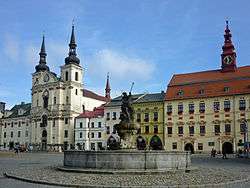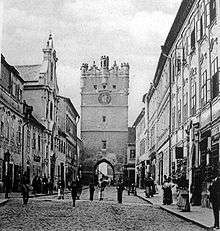Jihlava
Jihlava (Czech pronunciation: [ˈjɪɦlava] (![]()
Jihlava | |
|---|---|
 Masaryk Square with Saint Ignatius Church and City Hall | |
 Flag _-_coat_of_arms.gif) Coat of arms | |
 Jihlava Location in the Czech Republic | |
| Coordinates: 49°24′01″N 15°35′26″E | |
| Country | |
| Region | Vysočina |
| District | Jihlava |
| First documented | 1233 |
| Government | |
| • Mayor | Karolína Koubová (Fórum Jihlava) |
| Area | |
| • Total | 78.85 km2 (30.44 sq mi) |
| Elevation | 525 m (1,722 ft) |
| Population (2020-01-01[1]) | |
| • Total | 51,216 |
| • Density | 650/km2 (1,700/sq mi) |
| Time zone | UTC+1 (CET) |
| • Summer (DST) | UTC+2 (CEST) |
| Postal code | 586 01 |
| Website | www.jihlava.cz |
Among the principal buildings are the early Gothic churches of St. Jacob,[2] Friars Minor church of Our Lady and Dominican church of the Holy Cross, the Baroque church of St. Ignatius of Loyola, the Municipal Hall and a number of municipal houses containing Gothic and Renaissance details. There is also a Jewish cemetery, containing some remarkable monuments[2] including the tombstone of the parents of Gustav Mahler.
History
The origin of the city's name (Iglau in German) is unclear. Most common theory has it derived from the German word Igel, meaning hedgehog, usually in reference to the city's coat of arms. However, the name was in use since before the symbol of a hedgehog was. It is more likely the city is named for the river that flows through it, the name of which is also unclear in its origin, either being derived from the German word Igel as the first theory suggests, or from Slavic word jehla, referring to sharp stones in Jihlava river bed.[3] According to legend, silver was mined in Iglau as early as 799. King Ottokar I established a mint, and Iglau was granted extensive privileges already during these early times.
An old Slavic settlement upon a ford was moved to a nearby hill where the mining town was founded (ca. 1240) by king Wenceslaus I. In the Middle Ages the town was inhabited mostly by Germans (mostly from Northern Bavaria and Upper Saxony). Medieval mines surrounded by mining settlements were localized outside the walls of the medieval town (named Staré Hory).
In the era of the Hussite Wars, Jihlava remained a Catholic stronghold and managed to resist a number of sieges. Later at Jihlava, on 5 July 1436, a treaty was made with the Hussites, whereby the emperor Sigismund was acknowledged king of Bohemia.[2] A marble relief near the town marks the spot where Ferdinand I, in 1527, swore fidelity to the Bohemian estates.[2]
During the Thirty Years' War Jihlava was twice captured by the Swedes. In 1742, it fell into the hands of the Prussians, and in December 1805 the Bavarians under Wrede were defeated near the town.[2] In 1860, it became the childhood home of Bohemian-Austrian composer Gustav Mahler, who retained his ties to the town until the death of both of his parents in 1889.
Until World War I the town was an important Austro-Hungarian Army military center. In 1914, the First, Second and Third Battalions of the Moravian Infantry Regiment No. 81 (Bataillon des Mährischen Infanterie-Regiments Nummer. 81) and the Second Battalion of the Landwehr infantry regiment number 14 (II. Bataillon des Landwehr-Infanterie-Regiments Nr. 14) were the garrison troops.
After World War I the town constituted a German language island (Sprachinsel) within Slavic speaking Moravia. This affected local politics, as it remained the center of the second largest German-speaking enclave in the republic of Czechoslovakia (after Schönhengstgau/Hřebečsko). After the Czechoslovak Republic was proclaimed on 28 October 1918, the indigenous Germans of Bohemia and Moravia, claiming the right to self-determination according to the 10th of President Woodrow Wilson's Fourteen Points, demanded that their homeland areas remain with the new Austrian State. The Volksdeutsche of Iglau relied on peaceful opposition to the Czech military occupation of their region, a process that started on 31 October 1918 and was completed on 28 January 1919. Unsuccessful in getting their right to self-determination recognized and incorporated into the new Czechoslovakian state, many of the indigenous Germans instead took to more nationalistic politics. Thereafter extremist political figures like Hans Krebs, editor of the Iglauer Volkswehr newspaper, became prominent with the rise of Nazism and the Nazi occupation (1939–1945).

Until the end of World War II, Iglau was the center of a distinctive regional folk culture reflecting hundreds of years of local customs. The local dialect of German was a unique branch of Mitteldeutsch. Musicians often used homemade instruments and original groups of four fiddles (Vierergruppen Fiedeln) and Ploschperment. Typical folk dances were the Hatschou, Tuschen and Radln. Peasant women wore old "pairische" Scharkaröckchen costumes with shiny dark skirts and big red cloths.
Most of Jihlava's Jewish population was deported and killed due to the Holocaust in Bohemia and Moravia.[4]
After the end of World War II, and following the Beneš decrees, the German speakers were evicted; it is estimated that hundreds died on the arduous trek to Austria.[5] The town was repopulated with Czech and Moravian settlers favored by the new Communist regime. After 1951, the town was the site of several Communist show trials, which were directed against the influence of the Roman Catholic Church on the rural population. In the processes eleven death sentences were passed and 111 years of prison sentences imposed. All the convicted persons were rehabilitated after the Velvet Revolution.
In protest against the Soviet occupation of Czechoslovakia in 1969 Evžen Plocek set himself on fire in the town marketplace in emulation of others in Prague. Today there is a memorial plaque to him.
Since the collapse of Communism in the 1990s the share of employment in agriculture has steadily declined. The industrial sector of the town now employs 65 percent of all workers. In 2004, the Jihlava Polytechnic was set up and now has about 2,600 students.
Notable people
- Heinrich Breitenstein(1848–1930), Dutch military doctor, zoologist, and geographer in the Dutch East Indies
- Gustav Mahler (1860–1911), Austrian-German composer and conductor
- Julius Tandler (1869–1936), physician and politician
- Hans Krebs (1888–1947), Moravian-born Nazi SS Brigadeführer executed for war crimes
- Patrik Augusta (born 1969), ice hockey player
- Bobby Holík (born 1971), ice hockey player
- Lukáš Krpálek (born 1990), judoka
- David Rittich (born 1992), ice hockey player
Twin towns – sister cities
Jihlava is twinned with:[6][7]



References
- "Population of Municipalities – 1 January 2020". Czech Statistical Office. 2020-04-30.
- Chisholm, Hugh, ed. (1911). . Encyclopædia Britannica. 14 (11th ed.). Cambridge University Press. pp. 291–292.
- "Jihlavský ježek má stovky podob. Původ však halí tajemství". E15 (in Czech). Retrieved 22 October 2019.
- Hampel, Jens (1998). "Das Schicksal der jüdischen Bevölkerung der Stadt Iglau 1938–1942". Theresienstädter Studien und Dokumente (in German) (5): 70–99. CEEOL 64193.
- Lumans, Valdis O., “Himmler’s Auxiliaries; The Volksdeutsche Mittelstelle and the German National Minorities of Europe, 1933-1945” - 1993. ISBN 0-8078-2066-0 / ISBN 978-0-8078-2066-7
- "Partnerská města, Memoranda" (in Czech). Statutární město Jihlava. Retrieved 2020-06-18.
- "Polský Zgierz se stal partnerským městem Jihlavy" (in Czech). Statutární město Jihlava. 2018-08-22. Retrieved 2020-06-18.
Literature
- Peter von Chlumecký: Die Regesten oder die chronologischen Verzeichnisse der Urkunden in den Archiven zu Iglau […]. Nitsch & Grosse, Brünn 1856 (Digitalisat)
- Martin Leupold von Löwenthal: Chronik der Königlichen Stadt Iglau (1402–1607). Hrsg. v. Christian d' Elvert. Brünn 1861 (Digitalisat)
- Alois Pokorny: Die Vegetationsverhältnisse von Iglau. Ein Beitrag zur Pflanzengeographie des böhmisch-mährischen Gebirges. Wien 1852 (Digitalisat)
- Andreas Sterly: Drangsale der Stadt Iglau unter der schwedischen Zwingherrschaft. Iglau 1828 (Digitalisat)
- Johann Achatzi: Iglauer Heimatbuch. Gemeinschaft Iglauer Sprachinsel e.V. 1962
External links
| Wikimedia Commons has media related to Jihlava. |
| Wikivoyage has a travel guide for Jihlava. |